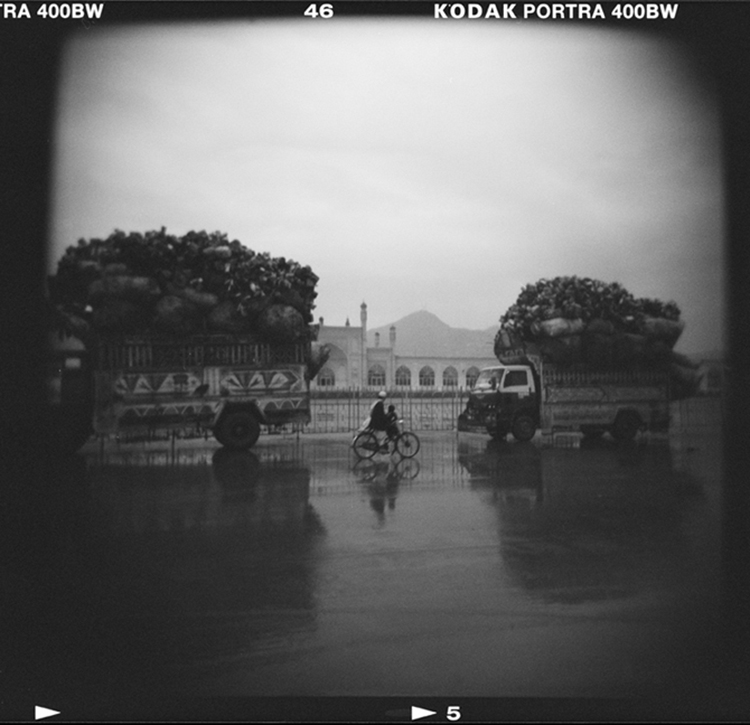Renewal: Afghanistan | Special issue on Afghanistan
A ‘New’ Contemporary Art In Afghanistan
If ‘modernism’ is about how cultures adapt to and absorb from one another and how they develop a distinct language over time, the golden age of art in Afghanistan can be accorded to namely the 16th century. Herat, then the capital of Afghanistan was a prominent centre in the east – an important trading post for India and China along the Mediterranean Sea. In this milieu the country witnessed an outstanding artist, Kamaluddin Behzad, who established a school of art (also known as the kitabkhana) that eventually had a resounding influence on Asian art through its integration of images and text embodied in the manuscript tradition (specimens of which abound in the British Library today).

From the series No Strings Attached by SumitDayal Afghanistan, 2007
With a similar sense of assimilation, centuries after the Timurid era, Amir Amanullah Khan (18921960), Afghanistan’s first modern ruler collaborated with the German government to establish the first industrial arts school in Kabul in 1921. Many such productive changes ensued so as to meld Afghan history with the contemporary – in the early 70’s, a second arts centre was established by the Ministry of Culture and Information called the Ghulam Mohammad Maimanagi Art Training Center; the Ministry of Higher Education developed the Fine Arts Faculty of Kabul University in 1976 and the Fine Arts Faculty of Herat University in 1986 as additional training centres, creating a strong base for the visual arts. As a consequence, artists such as Professor Ghulam Mohammad Maimanagi, Ustad Bereshna, Ustad Haidar Zada, Ustad Hamid Nawid and Ustad Yousef Kahzad among others were then educated in Germany, Italy and USA and hence played an important role in the consolidation ofWith a similar sense of assimilation, centuries after the Timurid era, Amir Amanullah Khan (18921960), Afghanistan’s first modern ruler collaborated with the German government to establish the first industrial arts school in Kabul in 1921. Many such productive changes ensued so as to meld Afghan history with the contemporary – in the early 70’s, a second arts centre was established by the Ministry of Culture and Information called the Ghulam Mohammad Maimanagi Art Training Center; the Ministry of Higher Education developed the Fine Arts Faculty of Kabul University in 1976 and the Fine Arts Faculty of Herat University in 1986 as additional training centres, creating a strong base for the visual arts. As a consequence, artists such as Professor Ghulam Mohammad Maimanagi, Ustad Bereshna, Ustad Haidar Zada, Ustad Hamid Nawid and Ustad Yousef Kahzad among others were then educated in Germany, Italy and USA and hence played an important role in the consolidation o fthese centres for future generations by generating a growing global network, further still working with artists from Turkey, India and France. This was an important second wave in the development of ‘Modern’ art of Afghanistan, which was abruptly interrupted with the invasion of the Soviet Union between 1928-1992. Subsequent restrictions on the freedom of speech and a full scale declaration of propaganda art ‘at the service of socialism and realism’ changed the dynamic within the country for all time to come.
In 1996, after the collapse of the Russian government in Afghanistan, a civil war encompassed the country, eventually having a debilitating effect on pedagogy. Any channel for creative expression was tethered as the subject of art itself was removed from the curriculum of schools and universities – practices such as sculpting, music, film, drawing and photography were indefinitely banned. The personal and professional life of an artist was scrutinised and then entirely censored.
However, the inability of any regime to undermine the arts and the free will of society was also inevitable. Since 2002, although the wars continue, significant personal efforts are being made through the Center for Contemporary Art (CCAA), Turquoise Mountain Foundation and the Afghan Institute in the University to reignite the liberal arts. CCAA, established in 2004, is the first such centre that created a space for the graphic arts, and as its Director, I am hopeful that such initiatives will represent a third wave of advancement in the region, fostering not only opportunity, leadership and participation but also protecting and projecting a renewed view of the arts in the country, beyond than what gets circulated through mass media.
At the same time, I feel that the global environment of institutional development must also be looked at with certain circumspection. With a drive to establish cultural mandates and fulfil their ‘liberal’ agendas, many international festivals use Afghanistan as an excuse to foreground their own reputations – but end up being self serving through a misguided sense of tokenism. The detrimental effect this creates is in terms of an insecurity – to be seen as ‘successful’ in the eyes of a European community, artists from Afghanistan often emulate contemporary trends emerging from the west. Such a tussle between an inner calling on the one hand, and an outer perception has created an undeniable rift, given the recent opening out of the country. It allows for a limited group to represent the larger entity of practices wherein lesser-known artists or those without access to the city get sidelined. With an emphasis on technical knowhow rather than form, feeling and function – the arts are now facing a real and decisive problematic, i.e. how to establish a representative regional identity, through an inclusive yet independent arts movement.